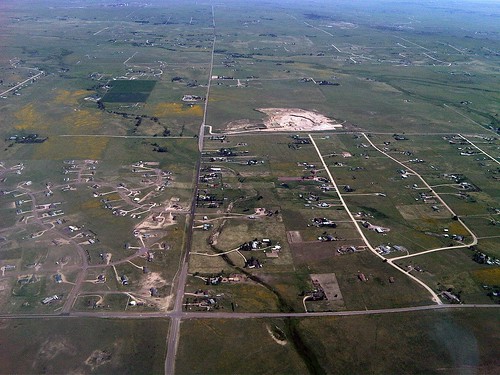The collapse of the "key assumptions" of sprawl

Posted April 25, 2011 at 1:30PM
For today’s entry I am happy to return to Washington Post commentator Roger Lewis, whose April 23 column analyzed market forces now favoring walkable neighborhoods over the automobile-dependent, sprawling subdivisions that characterized most US land development in the late 20th century. In particular, Lewis - sounding very much like the esteemed professor of architecture that he is - says that now-declining “suburban planning and zoning templates were predicated on four key assumptions”:
- America had an unlimited supply of land;
- Automobiles and road building, thanks to inexpensive and presumably inexhaustible supplies of petroleum, would forever satisfy metropolitan transportation needs;
- Grouping homogenous land uses, not intermixing them, would best protect property values, especially for residences; and
- The only way to realize the American dream was to own and inhabit a mortgaged house.
Today, all four of those assumptions have collapsed or are in the process of collapsing.  We now know that much of our land, especially in and around metro areas, should not be developed, because of risk (e.g., flooding, wildfire, landslides), limited resources (water), or ecological value. There is considerable variation in these factors from one place to another, but the supply of land in regions experiencing growth can no longer be seen as “unlimited.” Gasoline prices are back up to four bucks a gallon and, as demand for oil grows in developing countries, are surely going to continue to grow over the long term.
We now know that much of our land, especially in and around metro areas, should not be developed, because of risk (e.g., flooding, wildfire, landslides), limited resources (water), or ecological value. There is considerable variation in these factors from one place to another, but the supply of land in regions experiencing growth can no longer be seen as “unlimited.” Gasoline prices are back up to four bucks a gallon and, as demand for oil grows in developing countries, are surely going to continue to grow over the long term.
Lewis explains:
“Much of America’s land cannot or should not be developed. Dependency on oil and limitless use of cars pose daunting environmental, economic and geopolitical problems. Homogenizing and grouping land uses impede walkability, diminish transportation efficiency, waste energy and promote social segregation, all without necessarily enhancing real estate values. And when homeownership dreams recently became financial nightmares, many Americans discovered that having a house and a mortgage might not be all they were cracked up to be.”
Much of the rest of his column is devoted to changing demographic forces, which I have covered repeatedly: the projected growth in housing demand is going to come largely if not entirely from young people who are much more comfortable with urban lifestyles than their parents, and from retiring baby boomers who no longer have large families living at home that need large amounts of house and yard space.  Both groups value easy, walkable access to amenities at least as much as, if not more than, the benefits of a subdivision lifestyle based on driving significant distances and caring for lawns.
Both groups value easy, walkable access to amenities at least as much as, if not more than, the benefits of a subdivision lifestyle based on driving significant distances and caring for lawns.
We will still have continuing demand for large-lot suburbia, but the portion of the housing market that will seek it will be much smaller than it once was. In the 1960s families with kids comprised half or more of American households; that portion is down to a third and projected to shrink further to only a quarter.
Beyond demographic shifts per se, Canadian urban observer Wendy Waters (in her blog All About Cities) attributes the increase in demand for walkable places in part to changes in the larger economy and culture, including these:
- Maturation of the knowledge economy, reliant on the internet, that has benefited from a very urban workforce constantly looking for inspiration;
- De-industrialization in many metro areas as manufacturing declined either outright or as a percentage of employment (while service and knowledge jobs grew);
- Generations X and Y started to make their ideas and culture felt in cities,
 as they embraced an experience economy over a consumer goods and large-home-and-car based one;
as they embraced an experience economy over a consumer goods and large-home-and-car based one; - Women’s higher rate of degree attainment resulted in career women selecting short commutes and urban living (with the trade offs) over suburban homes;
- The fertility rate edged up slightly, likely as younger boomer and older gen x women who had postponed children had 1 or 2, but didn’t give up urban living or urban careers and wanted short commutes;
- Millennials defining freedom as their “first iPhone” rather than first car, and driving less;
- More recently in 2008 and now in 2011, high gas prices are encouraging more people to rethink automotive lifestyles.
Some observers suggest that 2010 US census data contradict these trends. Don’t believe them.
For example, conservative pundit Wendell Cox has made much of the fact that the overwhelming majority of US metro-area growth from 2000 to 2010 took place in suburbs, not “historical core municipalities.” Well, sure it did. But:
These aggregate numbers mask some very important facts, including that, in between, say, 1960 and 2000, many central cities were in severe decline, due to “white flight” and all sorts of perceived urban problems. But for some tragic exceptions like Detroit, that decline now has either slowed dramatically or reversed. In DC, for example, the central city is growing again after 50 years of decline and ironically, a new concern of some is that “white flight” is now to the city, not away from it. New York, Philadelphia, Indianapolis, Houston, Austin and San Antonio also grew. This is where the change is.
In addition, the distinction between “central city” and “suburb” is simply not what it once was. Inner-ring suburbs now are part of the central city in every way other than the arbitrary jurisdictional lines that mean little economically or environmentally. In his blog West North, my friend Payton Chung points out that the supposed “suburban” district of Friendship Heights Village, in Maryland but adjacent to the DC city limits, is “the single most densely populated place in the entire country, with 79,556 residents per square mile. Even Manhattan only clocks in at 69,468 per square mile.”
Another friend, Chris Leinberger, argues in enlightening commentary for The New Republic that the real juice in the market is with the growth of “walkable urban places,” regardless of the technicality of which jurisdiction they happen to fall within:
“Core cities are comprised of pedestrian-oriented urban places, how Jerry Seinfeld lived, but they also include auto-centric suburban places, like the San Fernando Valley in the city of Los Angeles or the Palisades in the District of Columbia. Likewise, the suburbs of those core cities include classic subdivisions and McMansions, like the home of Tony Soprano, but they also include booming places like Old Town Pasadena,
Reston Town Center near Dulles Airport outside D.C., and revitalized Jersey City and Hoboken, NJ, on the other side of the Hudson River from Manhattan.
“The issue is where are walkable urban places being built, and they are being built in both central cities and the suburbs surrounding them. My 2007 survey of the walkable urban places in the top 30 metros showed 50 percent of them were in central cities and 50 percent were in the suburbs. In the metro area with the most walkable urban places, the Washington region, 70 percent of the walkable urban places were in the suburbs. These included Bethesda and Silver Spring in suburban Montgomery County, nine places in suburban Arlington County (like Ballston and Crystal City), and the newly built Washington Harbor in suburban Prince George’s County.”
“R.A.” explained last month in a blog hosted by The Economist that, gross city/suburban numbers aside, the shift in relative demand for central city living (“that demand for central city life has grown relative to demand for suburban life”) has been dramatic. The writer also agrees with Chris that, even where suburban growth is taking place, much of it is in an urban form. But the truest indicator may be what has been happening with regard to home prices and values. Here’s R.A. on that point:
“Suburbs have seen massive housing growth and rapid population growth, but prices in central cities have soared, even in many places where population numbers are level or falling. If no one wanted to live in central cities, prices for homes there would not rise. And indeed, several decades ago, prices for homes in big central cities were dropping. But that trend has clearly reversed. You can't draw conclusions about demand shifts from population numbers alone.”
As I wrote some time back, when the housing market recovers, smart growth will claim a larger share than in the past. We’re already seeing it, and we are only going to see more. As Roger Lewis pointed out in the Post, we now know that the key assumptions that supported the sprawl paradigm are not valid.
Move your cursor over the images for credit information.

